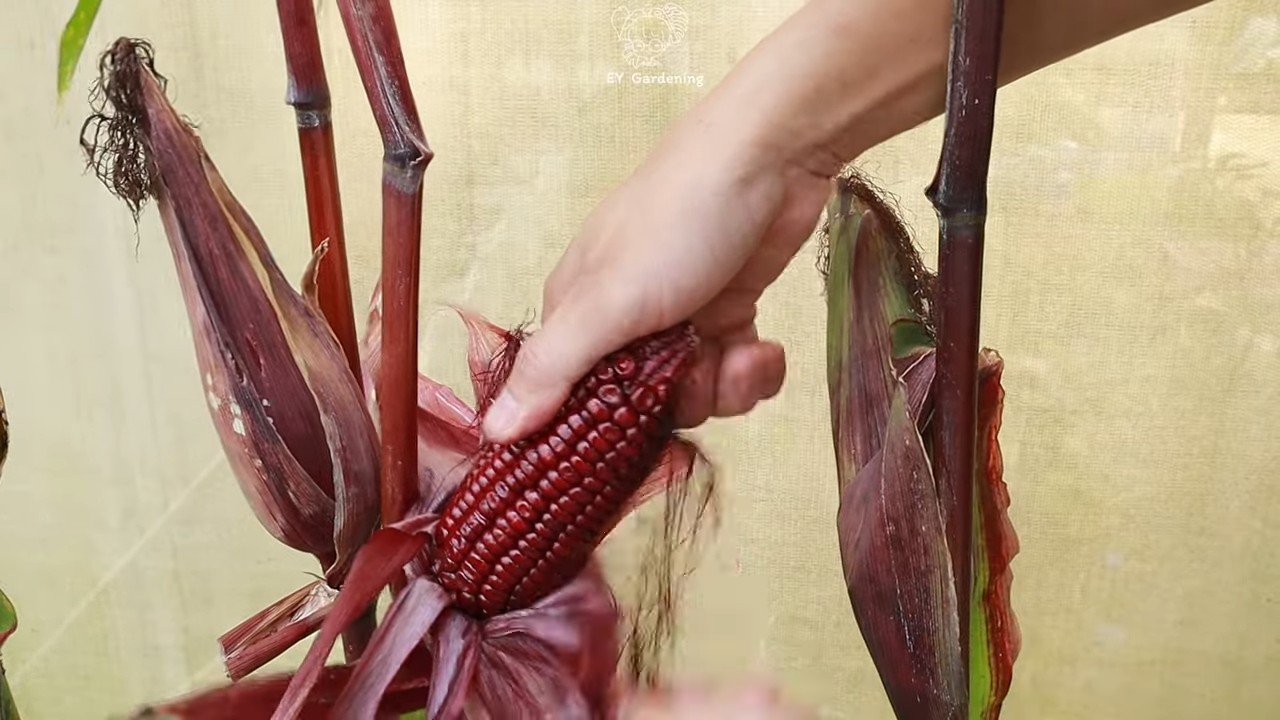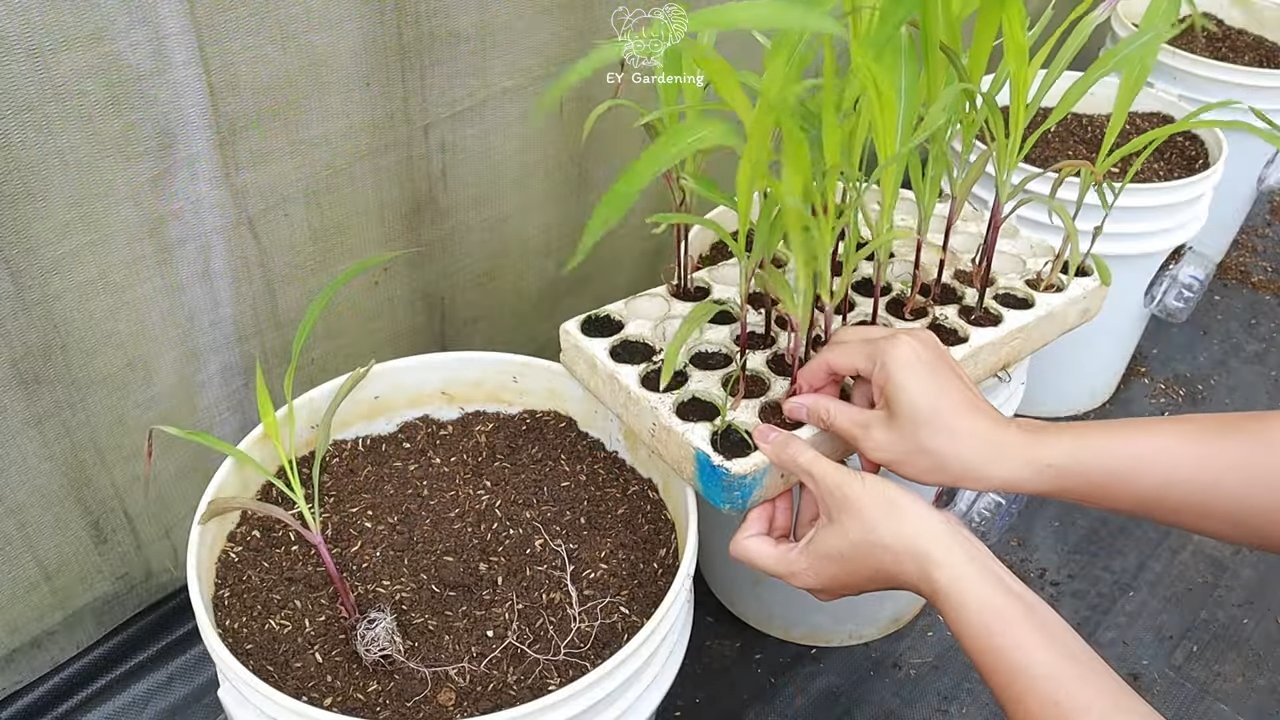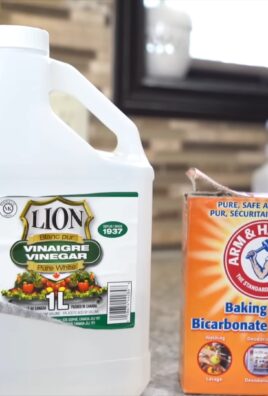Growing purple corn at home might sound like something out of a fairytale, but I’m here to tell you it’s totally achievable, and I’m going to show you how! Forget the same old yellow kernels; imagine vibrant, deep purple ears bursting with flavor and packed with antioxidants right from your own backyard.
For centuries, purple corn has been a staple in Andean cultures, particularly in Peru, where it’s known as “Maíz Morado.” It’s not just a pretty face; it’s revered for its health benefits and used in traditional drinks like “chicha morada.” Bringing this ancient grain into your garden connects you to a rich history and a vibrant culinary tradition.
Why should you bother with this unique project? Well, beyond the sheer novelty and bragging rights, growing purple corn at home offers a fantastic way to add a nutritional powerhouse to your diet. Plus, in a world increasingly concerned with food security and sustainable practices, cultivating your own food, especially something as unique as purple corn, is incredibly empowering. I’m excited to share some simple DIY tricks and hacks that will help you successfully grow this amazing plant, even if you’re a beginner gardener. Let’s get started!

Growing Your Own Vibrant Purple Corn: A DIY Guide
Hey there, fellow gardening enthusiasts! Ever dreamt of adding a splash of vibrant color to your garden and your dinner plate? Well, get ready to ditch the ordinary yellow and embark on a journey into the world of purple corn! It’s not just a novelty; it’s packed with antioxidants and makes for some seriously stunning tortillas and cornbread. I’m going to walk you through everything you need to know to successfully grow your own purple corn at home.
Choosing Your Purple Corn Variety
Before we get our hands dirty, let’s talk varieties. Not all purple corn is created equal! Different varieties have different growing requirements and shades of purple. Here are a few popular options:
* ‘Hopi Blue’: This is a classic choice, known for its deep blue-purple kernels and drought tolerance. It’s a great option if you live in a drier climate.
* ‘Oaxacan Purple’: Originating from Mexico, this variety boasts intensely purple kernels and is often used for making traditional beverages.
* ‘Cherokee Purple’: While technically a dent corn, it has beautiful purple hues and is excellent for grinding into cornmeal.
* ‘Blue Clarage’: Another dent corn variety, known for its striking blue-purple color and suitability for cornmeal and hominy.
Do some research and choose a variety that suits your climate and culinary preferences. I personally love ‘Hopi Blue’ for its resilience and beautiful color.
Preparing for Planting: Location, Soil, and Timing
Okay, so you’ve picked your variety. Now, let’s get the groundwork laid (literally!). Purple corn, like all corn, needs a sunny spot and well-drained soil.
* Sunlight: Aim for at least 6-8 hours of direct sunlight per day. Corn is a sun-loving plant!
* Soil: The ideal soil is well-draining, fertile, and slightly acidic to neutral (pH 6.0-7.0). Amend your soil with compost or well-rotted manure to improve drainage and fertility.
* Timing: Purple corn is a warm-season crop, so you’ll want to plant it after the last frost. The soil temperature should be at least 60°F (15°C). Check your local frost dates to determine the best planting time for your area. I usually wait until a week or two after the last expected frost just to be safe.
Step-by-Step Planting Guide
Alright, let’s get those seeds in the ground!
1. Prepare the Soil: Before planting, loosen the soil to a depth of about 12 inches. Remove any rocks, weeds, or debris. Incorporate compost or manure into the soil to enrich it. I like to use a garden fork to really get the compost mixed in well.
2. Planting Seeds: Plant the seeds about 1-2 inches deep and 6-12 inches apart in rows. Space the rows about 2-3 feet apart. Planting in blocks (rather than long, single rows) helps with pollination.
3. Watering: Water the seeds thoroughly after planting. Keep the soil consistently moist, but not waterlogged, until the seedlings emerge.
4. Thinning (if necessary): Once the seedlings are a few inches tall, thin them to the strongest plant every 6-12 inches. This gives each plant enough room to grow and thrive. I know it’s hard to pull out those little seedlings, but it’s essential for a good harvest!
Caring for Your Purple Corn
Now that your purple corn is planted, it’s time to nurture it and watch it grow!
1. Watering: Corn needs consistent moisture, especially during tasseling and silking (when the tassels and silks appear). Water deeply once or twice a week, depending on the weather. I always check the soil moisture before watering – if the top inch or two is dry, it’s time to water.
2. Fertilizing: Corn is a heavy feeder, so it benefits from regular fertilization. Apply a balanced fertilizer (e.g., 10-10-10) according to the package instructions. You can also side-dress with compost or manure. I like to use a slow-release fertilizer to provide a steady supply of nutrients.
3. Weeding: Keep the area around your corn plants free of weeds. Weeds compete with the corn for water and nutrients. Hand-pull weeds regularly or use a hoe to cultivate the soil.
4. Pest Control: Keep an eye out for common corn pests, such as corn earworms, aphids, and Japanese beetles. Use organic pest control methods, such as insecticidal soap or neem oil, if necessary. I’ve found that attracting beneficial insects, like ladybugs, can also help control pests naturally.
5. Pollination: Corn is wind-pollinated, so it’s important to ensure good air circulation. Planting in blocks helps with pollination, as the plants can pollinate each other more easily. If you notice poor pollination (kernels not filling out properly), you can hand-pollinate by gently shaking the tassels over the silks.
Harvesting Your Purple Corn
The moment you’ve been waiting for! Knowing when to harvest is key to getting the best flavor and color.
1. Timing: The harvest time depends on the variety and your intended use. For fresh eating (corn on the cob), harvest when the silks have turned brown and dry, and the kernels are plump and milky. For drying and grinding into cornmeal, allow the ears to dry on the stalk until the husks are completely dry and brown.
2. Checking for Ripeness: To check for ripeness, peel back a portion of the husk and puncture a kernel with your fingernail. If the liquid is milky, it’s ready for fresh eating. If the kernels are hard and dry, it’s ready for drying.
3. Harvesting: To harvest, grasp the ear firmly and twist it downward. The ear should snap off easily.
4. Drying (if necessary): If you’re drying the corn for cornmeal, remove the husks and hang the ears in a well-ventilated area until they are completely dry. This can take several weeks. I like to hang them in my garage where it’s dry and protected from the elements.
Using Your Purple Corn
Now for the fun part – enjoying the fruits (or rather, vegetables!) of your labor!
* Fresh Eating: Boil, steam, or grill your fresh purple corn on the cob. The color will deepen when cooked.
* Cornmeal: Grind your dried purple corn into cornmeal using a grain mill or food processor. Use the cornmeal to make cornbread, tortillas, or other baked goods. The purple cornmeal will give your dishes a beautiful color and a slightly nutty flavor.
* Tortillas: Make homemade purple corn tortillas. They’re not only visually stunning but also incredibly delicious.
* Cornbread: Bake a loaf of purple cornbread. It’s a great way to showcase the vibrant color of your homegrown corn.
* Decorative Purposes: Dried purple corn ears can also be used for decorative purposes. They add a touch of rustic charm to your home.
Troubleshooting Common Problems
Even with the best planning, you might encounter a few challenges along the way. Here are some common problems and how to address them:
* Poor Germination: If your seeds aren’t germinating, make sure the soil is warm enough and consistently moist. You can also try soaking the seeds in water for 24 hours before planting to improve germination rates.
* Stunted Growth: Stunted growth can be caused by nutrient deficiencies, poor soil drainage, or pest infestations. Amend your soil with compost or fertilizer, improve drainage, and control pests as needed.
* Poor Pollination: Poor pollination can result in ears with missing kernels. Ensure good air circulation, plant in blocks, and hand-pollinate if necessary.
* Pest Infestations: Monitor your plants regularly for pests and take action promptly. Use organic pest control methods whenever possible.
Saving Seeds for Next Year
If you want to grow purple corn again next year, you can save seeds from your harvest.
1. Select Healthy Ears: Choose ears from healthy, vigorous plants that exhibit the desired characteristics (e.g., deep purple color, large kernels).
2. Allow Ears to Dry Completely: Allow the ears to dry completely on the stalk or in a well-ventilated area.
3. Remove Kernels: Once the ears are dry, remove the kernels from the cob.
4. Store Seeds: Store the seeds in an airtight container in a cool, dry place.
Growing purple corn is a rewarding experience that adds beauty and flavor to your garden and your table. With a little planning and care, you can enjoy a bountiful harvest of this unique and nutritious crop. Happy gardening!

Conclusion
So, there you have it! Growing purple corn at home isn’t just a quirky gardening experiment; it’s a gateway to vibrant colors, enhanced nutrition, and a truly unique culinary experience. Forget the bland, predictable yellow corn – imagine the stunning visual impact of deep purple kernels adorning your table, adding a touch of royalty to your cornbread, tortillas, or even a simple bowl of polenta.
This DIY trick is a must-try for several compelling reasons. First and foremost, you gain complete control over the growing process, ensuring your purple corn is free from harmful pesticides and herbicides. You know exactly what goes into your food, from the soil it’s grown in to the water it receives. This is especially important for those seeking organic and sustainable food sources.
Secondly, growing your own purple corn allows you to harvest it at its peak ripeness, maximizing its flavor and nutritional value. Commercially grown corn is often harvested before it’s fully mature to facilitate transportation and storage, which can compromise its taste and nutrient content. Homegrown purple corn, on the other hand, is bursting with flavor and packed with antioxidants, thanks to its high anthocyanin content.
Beyond the health benefits, the sheer novelty of growing purple corn is a reward in itself. It’s a conversation starter, a source of pride, and a fantastic way to connect with nature. Imagine the delight of sharing your homegrown purple corn with friends and family, showcasing your gardening prowess and introducing them to a truly unique and delicious food.
But the possibilities don’t end there! Consider experimenting with different varieties of purple corn to discover your favorite flavor profile. Some varieties are sweeter, while others have a more earthy or nutty taste. You can also explore different growing techniques, such as companion planting, to enhance the yield and health of your purple corn plants.
For example, try planting beans alongside your corn to provide nitrogen to the soil, or plant squash to help suppress weeds and retain moisture. You could even try growing your purple corn in containers if you have limited space. The beauty of DIY gardening is that you can adapt and customize the process to suit your specific needs and preferences.
We encourage you to embrace the challenge and embark on your own purple corn growing adventure. Don’t be afraid to experiment, learn from your mistakes, and most importantly, have fun! The rewards are well worth the effort.
And once you’ve harvested your beautiful purple corn, we’d love to hear about your experience! Share your photos, recipes, and tips with us in the comments section below. Let’s create a community of purple corn enthusiasts and inspire others to discover the joys of growing their own food. So, grab your seeds, get your hands dirty, and prepare to be amazed by the magic of growing purple corn at home!
Frequently Asked Questions (FAQ)
What exactly is purple corn, and why is it purple?
Purple corn is a variety of corn that gets its vibrant color from anthocyanins, which are natural pigments also found in blueberries, raspberries, and other purple-colored fruits and vegetables. These anthocyanins are powerful antioxidants that offer a range of health benefits. Unlike regular yellow corn, purple corn has a higher concentration of these beneficial compounds, making it a nutritional powerhouse. The specific shade of purple can vary depending on the variety of corn and the growing conditions.
Is it difficult to grow purple corn compared to regular corn?
Generally, growing purple corn is not significantly more difficult than growing regular corn. The basic requirements for sunlight, water, and soil are the same. However, some varieties of purple corn may be more susceptible to certain pests or diseases, so it’s important to choose a variety that is well-suited to your local climate and growing conditions. Proper soil preparation, adequate watering, and regular monitoring for pests and diseases are essential for successful purple corn cultivation.
What kind of soil is best for growing purple corn?
Purple corn thrives in well-drained soil that is rich in organic matter. A slightly acidic to neutral pH (between 6.0 and 7.0) is ideal. Before planting, amend the soil with compost, aged manure, or other organic materials to improve its fertility and drainage. If your soil is heavy clay, consider adding sand or other amendments to improve its structure. A soil test can help you determine the specific nutrient needs of your soil and guide your fertilization strategy.
How much sunlight does purple corn need?
Purple corn requires at least 6-8 hours of direct sunlight per day to thrive. Choose a planting location that receives ample sunlight throughout the growing season. If you live in a particularly hot climate, some afternoon shade may be beneficial to prevent the plants from overheating. Insufficient sunlight can lead to stunted growth, reduced yields, and less vibrant color in the kernels.
How often should I water my purple corn plants?
Water your purple corn plants regularly, especially during dry periods. The soil should be kept consistently moist, but not waterlogged. Water deeply and less frequently, rather than shallowly and more often, to encourage deep root growth. The frequency of watering will depend on the weather conditions, soil type, and stage of plant growth. Check the soil moisture regularly and adjust your watering schedule accordingly.
What are some common pests and diseases that affect purple corn?
Common pests that can affect purple corn include corn earworms, corn borers, and aphids. Diseases that can affect purple corn include corn smut, leaf blight, and stalk rot. Regular monitoring of your plants for signs of pests and diseases is crucial for early detection and treatment. Use organic pest control methods whenever possible, such as introducing beneficial insects or applying neem oil. Choose disease-resistant varieties of purple corn to minimize the risk of disease outbreaks.
When is the best time to harvest purple corn?
The best time to harvest purple corn is when the kernels are fully mature and the silks have turned brown and dry. The kernels should be plump and filled with a milky substance. You can test for ripeness by piercing a kernel with your fingernail. If the liquid is milky, the corn is ready to harvest. If the liquid is clear, the corn needs more time to mature.
Can I save seeds from my purple corn to plant next year?
Yes, you can save seeds from your purple corn to plant next year, but keep in mind that if you are growing other types of corn nearby, there is a chance of cross-pollination, which could affect the color and characteristics of the next generation of corn. To ensure that you are saving true-to-type seeds, isolate your purple corn from other corn varieties by at least 200 feet. Allow the corn to fully mature on the stalk, then dry the ears thoroughly before shelling the kernels and storing them in a cool, dry place.
What are some ways to use purple corn in cooking?
Purple corn can be used in a variety of culinary applications. It can be ground into flour for making tortillas, cornbread, and other baked goods. It can also be used to make polenta, atole (a traditional Mexican drink), and even purple corn beer. The kernels can be roasted or grilled and eaten as a side dish. The vibrant color of purple corn adds a unique visual appeal to any dish.
Where can I buy purple corn seeds?
Purple corn seeds can be purchased from a variety of sources, including online seed companies, local nurseries, and garden centers. Look for reputable suppliers that offer high-quality seeds and provide information about the specific variety of purple corn you are purchasing. Be sure to choose a variety that is well-suited to your local climate and growing conditions.




Leave a Comment